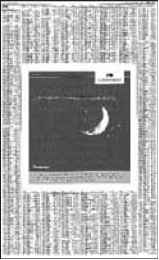The Newspaper Audience
As with any medium, the media planner must understand the nature and size of the audience reached by a newspaper in considering its value in the media plan. Since newspapers as a class of media do an excellent job of penetrating their market, the typical daily newspaper gives advertisers the opportunity to reach most of the households in a market. But, while local advertisers aim to cover a particular market or trade area, national advertisers want to reach broad regions or even the entire country. They must purchase space in a number of papers to achieve the desired level of coverage.
The basic sources of information concerning the audience size of newspapers come from the circulation figures available through rate cards, publishers' statements, or Standard Rate and Data Service's Newspaper Rates and Data. Circulation figures for many newspapers are verified by the Audit Bureau of Circulation which was discussed earlier. Advertisers that use a number of papers in their media plan generally find SRDS the most convenient source.
Newspaper circulation figures are generally broken down into three categories: the city zone, the retail trading zone, and all other areas. The city zone is a market area composed of the city where the paper is published and contiguous areas similar in character to the city. The retail trading zone is the market outside the city zone whose residents regularly trade with merchants within the city zone. The "all other" category covers all circulation not included in the city or retail trade zone.
Sometimes circulation figures are provided only for the primary market, which is the city and retail trade zones combined, and the other area. Both local and national advertisers consider the circulation patterns across the various categories in evaluating and selecting newspapers.
Exhibit 12-23 Island ads are a way to break through the clutter in newspaper advertising
Exhibit 12-23 Island ads are a way to break through the clutter in newspaper advertising

National advertisers often buy newspaper space on the basis of the size of the market area they cover. For example, General Motors might decide to purchase advertising in the top 10 markets, the top 50 markets, the top 100 markets, and so on. A national advertiser gets different levels of market coverage depending on the number of market areas purchased.
Audience Information Circulation figures provide the media planner with the basic data for assessing the value of newspapers and their ability to cover various market areas. However, the media planner also wants to match the characteristics of a newspaper's readers with those of the advertiser's target audience. Data on newspaper audience size and characteristics are available from studies conducted by the papers as well as from commercial research services. As for magazines, a very valuable source for information on newspapers is the Standard Rate and Data Service (SRDS), whose print and online service provides complete planning information on daily papers, newspaper groups, ethnic newspapers, college newspapers, comics, and newspaper-distributed magazines. The SRDS data contain standardized ad rates, circulation figures, dates, general requirements, contact information, and other valuable information for media.
Companies such as Simmons Market Research Bureau and Mediamark Research Inc. provide syndicated research studies on lifestyles, media behavior, and product/ brand preferences that include information on newspapers. These studies can be valuable for comparing newspapers with other media vehicles.
Many newspapers commission their own audience studies to provide current and potential advertisers with information on readership and characteristics of readers such as demographics, shopping habits, and lifestyles. These studies are often designed to promote the effectiveness of the newspaper in reaching various types of consumers. Since they are sponsored by the paper itself, many advertisers are skeptical of their results. Careful attention must be given to the research methods used and conclusions drawn by these studies.
Continue reading here: Purchasing Newspaper Space
Was this article helpful?

